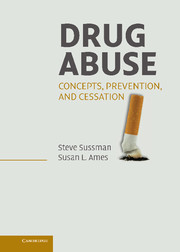Book contents
- Frontmatter
- Contents
- Preface
- Acknowledgments
- SECTION ONE CONCEPTS AND CLASSES OF DRUGS
- SECTION TWO ETIOLOGY
- SECTION THREE PREVENTION
- SECTION FOUR CESSATION
- 15 Concepts of Cessation
- 16 Neurobiologically Relevant
- 17 Cognitive Processes
- 18 Social Interaction and Social Groups
- 19 The Large Social and Physical Environment
- SECTION FIVE CONCLUSIONS AND THE FUTURE
- References
- Author Index
- Subject Index
18 - Social Interaction and Social Groups
Published online by Cambridge University Press: 18 December 2009
- Frontmatter
- Contents
- Preface
- Acknowledgments
- SECTION ONE CONCEPTS AND CLASSES OF DRUGS
- SECTION TWO ETIOLOGY
- SECTION THREE PREVENTION
- SECTION FOUR CESSATION
- 15 Concepts of Cessation
- 16 Neurobiologically Relevant
- 17 Cognitive Processes
- 18 Social Interaction and Social Groups
- 19 The Large Social and Physical Environment
- SECTION FIVE CONCLUSIONS AND THE FUTURE
- References
- Author Index
- Subject Index
Summary
This chapter presents drug misuse treatment from the perspective of social interaction processes and social group structure. There are many cessation strategies that make use of social processes. For example, sometimes a “motivational intervention” is implemented to confront the drug misuser with his or her detrimental effects on others. Once recognition of the problem behavior is understood or perhaps debated among the drug misuser and others, formal or informal treatment providers (e.g., a therapist, twelve-step sponsor or group) may be selected either by the drug misuser or by external agents.
Next, therapeutic relationships are attempted. If a solid therapeutic alliance is created (i.e., a trusting and mutually respectful relationship is developed), progress toward solutions to problematic substance use will be achieved. The person in recovery may attempt to learn alternative social behaviors. Social skills training, such as assertiveness training and anger or other mood management, may be needed for some individuals to attempt reintegration into a drug-free social world. Additional social-level therapeutic modalities may need to be provided as well, including involvement in a recovery community.
In this chapter, we include a brief discussion of the use of the Johnson Institute's motivational intervention. Next, we discuss the twelve-step group recovery model, selection of therapeutic agents, and establishing the therapeutic relationship. Use of motivational interviewing is mentioned as one tool for solidifying the therapeutic relationship.
- Type
- Chapter
- Information
- Drug AbuseConcepts, Prevention, and Cessation, pp. 248 - 261Publisher: Cambridge University PressPrint publication year: 2008



